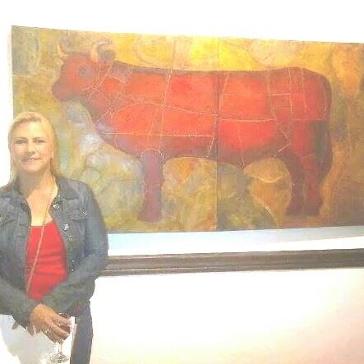KERRY WALLACE

Internal Tapping
"Sir Laurens van der Post wrote of the San people of the Kalahari -an indigenous hunter-gatherer culture of Southern Africa-who use tapping.
Tapping is an ancient knowing. Listening to that inner voice of the soul, and acknowledging its call. The creative process shares direct parallels to tapping. The artist as a conduit.
This is of great of interest to me '' - Wallace
ARTIST STATEMENT
''Predominantly a landscape artist I am drawn to aerial views. As from an aeroplane onto the spread of the landscape below. There is something empowering about the omniscience view of a scene from this vantage point. Being able to direct the scene, or the objects that present themselves. Like counters in a game, the visual objects create conversations and tensions. I find the idea of controlling the outcome conflicting. The question if should there be a remedy, or relief.
The landscape becomes a metaphor for the state of being. Conditions physical, emotional, or economical. There is a meditation on isolation, and mortality. Cattle or the cow are solitary entities. A metaphor for various states of the vulnerability of the human condition. Cattle are revered within African and other cultures. Contrasting areas of visual, or physical divides on the canvas represent the disenfranchised. The idea of the grass is greener, or the cow that becomes the landscape in some paintings, or at times 'Meat scapes'.
Using unconventional materials is a way to restrict being seduced by more traditional materials. Rather to become empathetic towards the base materials. Blackened landscapes of wax and black shoe polish are reminiscent of the controlled, and deliberate burning of the African bushveld. Etching onto the wax also has the appearance of African woodcuts. Experimenting with wax, fabric dye, shoe polish, clay, and found objects the paintings become three dimensional, and sculptural. Using wax is appealing because of its translucent nature, and the peeling flesh like quality. Modelling the clay cattle, and whittling the horns from wood has its roots in African culture. Clay cows in sparse dry areas become metaphors for spiritual drought. The work is subjective, and representational. Through the past few years of COVID-19 lockdowns, I explored situational dynamics within confined environments. I work in an aleatoric or 'chance controlled' way.''
The artist works with unconventional materials. Commentary on societal issues are at the forefront of the artworks. Wallace supplies commissioned artwork nationally, and internationally.